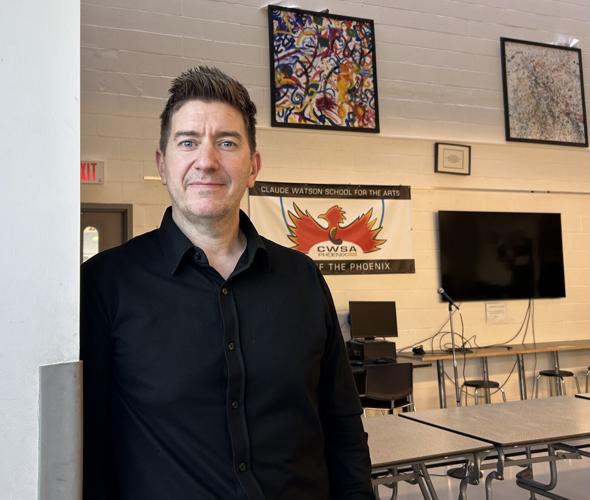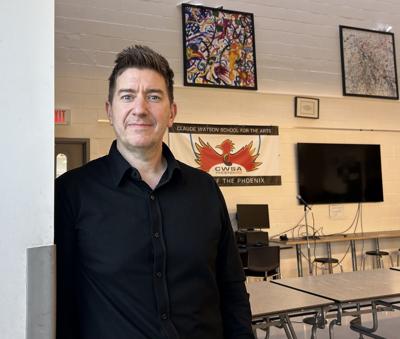Gabriel Radford was introduced to the French horn in Grade 5 by the music instructor at his º£½ÇÉçÇø¹ÙÍøpublic school. It would prove instrumental in him becoming a professional musician.
“This was my entry point, not just into music, but into a sense of identity, of purpose and belonging,” recalled Radford, who plays horn in the º£½ÇÉçÇø¹ÙÍøSymphony Orchestra.
“None of this would have happened without early access to music education,” he said Thursday at a community meeting about the importance of music education in schools.
“Music is the ultimate level playing field...You don’t need private lessons or expensive gear to join the school band or choir. You just need a school that believes that music belongs in every life and a teacher to make it happen.”
His comments come as the º£½ÇÉçÇø¹ÙÍøDistrict School Board grapples with a projected $58 million deficit for the 2025-26 year, and trustees weigh where to make cuts in order to balance the books.
TDSB  that include eliminating a music program available in elementary schools and axing all 74 itinerant music instructors — professional musicians who enrich the curriculum by teaching band, strings, steel pan and vocal music. It’s a proposal that has elicited public backlash.
According to a staff report, the program is unique to the TDSB, which upon amalgamation inherited it from the former Etobicoke, Scarborough and º£½ÇÉçÇø¹ÙÍøboards. A key concern is that it isn’t funded by the ministry, costing about $5 million a year. Also, the instructors work in 277 schools, but there are 192 schools without the program, “which raises significant concern about equity of access.”Â
Staff maintain that even without these instructors, the board would have “a robust music program” delivered by teachers. (In Ontario, all elementary teachers can teach music.) Because teachers have partnered with instructors, they’ve learned from them and will be prepared to run their own lessons as part of “a renewed music program model” that would begin next fall. If instructors are cut, staff recommends investing $1 million into training teachers and buying new instruments.

Nick Godsoe, director of programs and education at MusiCounts, says “without robust music education, we weaken the pipeline of future artists, songwriters, producers and music industry professionals.” Seen here at Claude Watson School for the Arts.
Isabel Teotonio“The TDSB is committed to providing students with access to strong instructional music programs,” reads the staff report. “This commitment is grounded in equity as a guiding principle, ensuring that all students have opportunities to participate and excel in our music program.”
But Trustee Weidong Pei, who hosted the meeting at a school in his ward, says this isn’t an equity issue, because the itinerant music instructor program is available to any principal who applies, noting “not a single request is turned down.”Â
“These programs are not extracurricular luxuries — they are core to a well-rounded, engaging, and equitable public education,” he says, adding they foster discipline, creativity, teamwork and emotional well-being.
“Cutting the (itinerant music instructor) program would disproportionately harm students in schools that rely on shared instructors to access quality music learning, especially those without the means to supplement this education privately.”
Nick Godsoe of MusiCounts, a national music education charity, worries that if regular classroom teachers are teaching band or strings, kids won’t get proper instruction, or the instruments may go unused.
“In just the past 10 years, we’ve invested more than $700,000 into 68 (TDSB) schools,” says the charity’s director of programs and education. “But for these investments to work and to be worthwhile and to be sustainable, we need school boards to recognize the importance of having qualified music specialists in place to properly utilize this highly specialized equipment.”
Itinerant music instructor David Spek, also treasurer at CUPE Local 4400, says the key issue is that “the provincial government continues to underfund education.” He’s in support of the music program and contact members of provincial parliament to advocate for fair funding.
The , meaning it spends more than it receives in funding from the Ministry of Education. It says reasons for this include a $1,500 shortfall in per-student provincial funding when adjusted for inflation; unfunded increases in statutory benefits (Canada Pension Plan and Employment Insurance); salaries that exceed ministry benchmarks; and the inability to close under-used schools because of a provincial moratorium.
Education Minister Paul Calandra says the province has increased education funding to historic levels and has sent financial investigators into the TDSB — and the city’s Catholic board — to probe their finances.Â





























To join the conversation set a first and last name in your user profile.
Sign in or register for free to join the Conversation